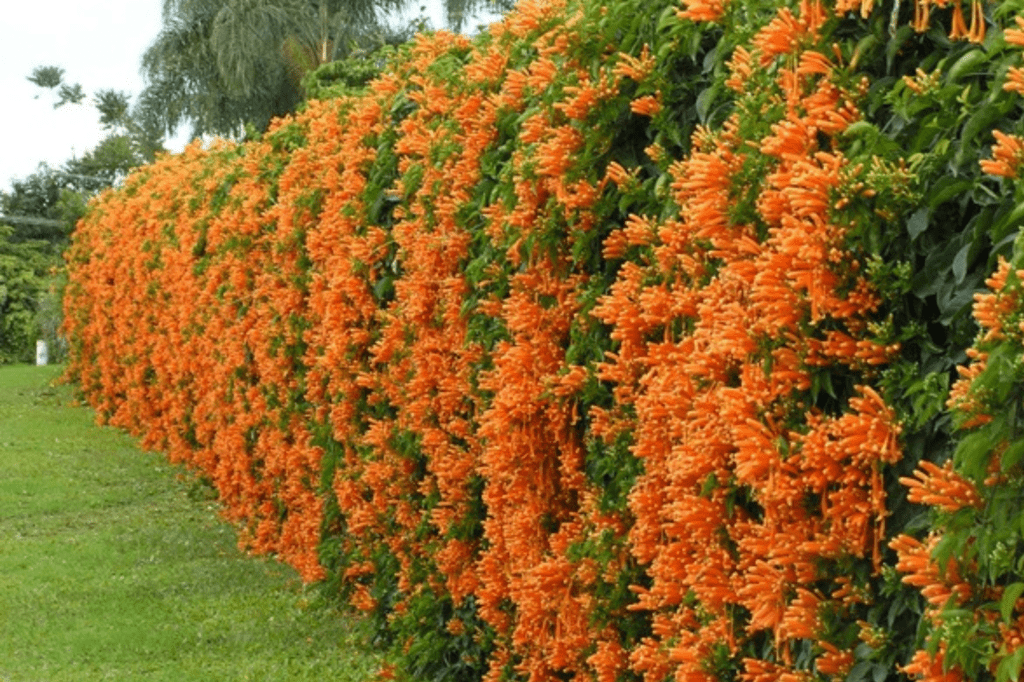If you’re a plant enthusiast or just someone who loves to learn about the natural world, then you’ll be intrigued by the wild orange trumpet vine. This plant, with its vibrant orange blooms, is a stunner in any garden or landscape. But have you ever wondered what it’s called? In this section, we’ll explore the different names used to refer to this beautiful plant.
Key Takeaways
- The wild orange trumpet vine is a stunning plant with vibrant orange blooms.
- There are different names used to refer to the wild orange trumpet vine.
The Beauty of the Orange Trumpet Vine
If you’re looking for a vibrant, show-stopping plant to add to your garden, look no further than the orange trumpet vine. This stunning vine plant is a popular choice for its striking orange-red flowers that bloom throughout the summer months. The trumpet-shaped blooms are not only eye-catching but also attract hummingbirds and other pollinators to your garden.
But the beauty of the orange trumpet vine goes beyond its blooms. The plant also has lush green foliage that creates a lovely backdrop and texture against other plants in your garden. The vine can grow up to 30 feet, making it an excellent choice for climbing up trellises, fences, or walls. The woody stem of the vine also adds an element of interest and texture to your garden.
The Beauty of the Orange Trumpet Vine
One of the most enchanting attributes of the orange trumpet vine is its versatility. It can be planted in a variety of soil types and is drought-resistant once established, making it an ideal choice for gardens in many regions. The vine plant can be trained to grow vertically or horizontally, and it’s a great option for covering unsightly areas or adding privacy to your yard.
Another wonderful quality of the orange trumpet vine is its easy maintenance. With proper pruning, it can be kept under control, and it rarely has issues with pests or diseases. However, keep in mind that the vine can be aggressive, so it’s important to plant it in an area where it has plenty of space to grow without overtaking other plants in your garden.
Characteristics of the Wild Orange Vine
If you’re looking to add some color and vibrancy to your garden, the wild orange trumpet vine is a superb choice. This striking vine plant is known for its trumpet-shaped flowers that range in color from bright orange to a deep reddish-orange hue, and it’s certain to attract hummingbirds, butterflies, and other pollinators to your garden.
The wild orange vine is a fast-growing climbing vine that can reach heights of up to 30 feet in ideal growing conditions. It has a woody stem and grows quickly, covering trellises, pergolas, fences, and other structures with its lush foliage and gorgeous blooms. The flowers typically bloom in the summer and fall, creating a stunning display of color and attracting a range of wildlife to your yard.
Distinctive Characteristics of the Wild Orange Vine
| Characteristic | Description |
|---|---|
| Leaf Shape | The wild orange vine features glossy, dark green leaves that are oval-shaped and pointed. |
| Flower Color | The trumpet-shaped flowers on the wild orange vine are bright orange to red-orange in color and have a yellow throat. |
| Size | The wild orange vine can grow up to 30 feet high and 30 feet wide in ideal growing conditions. |
| Preferred Growing Conditions | The wild orange vine thrives in full sun to partial shade, in well-drained soil that is kept consistently moist. |
While the wild orange vine is a hardy and vigorous plant that generally requires little maintenance once established, it’s important to note that it can become invasive and spread quickly if not kept in check. Regular pruning is recommended to help control growth and prevent it from becoming a nuisance.
Tip: Be sure to wear gloves and protective clothing when pruning the wild orange vine, as the sap can cause skin irritation.
Trumpet Vine: The Perfect Addition to Your Garden
Looking for a stunning, low-maintenance vine to add to your garden? Look no further than the trumpet vine. This ornamental vine plant boasts bold, trumpet-shaped flowers that bloom in vibrant shades of orange, attracting hummingbirds and butterflies to your yard.
Trumpet vines are both versatile and easy to care for, making them an ideal addition to any garden or landscape design. Whether you’re looking to add some height to your garden beds or create a beautiful wall of vibrant blooms, the trumpet vine can do it all.
| Plant Type | Features |
|---|---|
| Climbing Vine | Can climb up to 30 feet, perfect for accenting trellises, arbors, and fences. |
| Flowering Vine | Produces striking trumpet-shaped blooms in shades of orange and red throughout the summer months, attracting pollinators like hummingbirds and butterflies to your garden. |
| Ornamental Vine | With its attractive foliage and show-stopping blooms, the trumpet vine makes a stunning statement piece in any garden. |
Trumpet vines are hardy and drought-tolerant, making them a low-maintenance option for gardeners of all skill levels. They prefer full sun to partial shade and well-drained soil, but can adapt to a variety of growing conditions and soil types.
If you’re looking to add some color and texture to your garden design, consider incorporating a trumpet vine. Its impressive ornamental qualities and ease of care make it a smart choice for any gardener.
Cultivating and Caring for the Orange Trumpet Vine
If you’re thinking of adding an orange trumpet vine to your garden, you’ll want to ensure you know how to properly cultivate and care for it. Here are some key tips:
Ideal Growing Conditions
The orange trumpet vine thrives in warm climates and enjoys full sun exposure. It also prefers well-draining soil, so make sure to choose a suitable location that allows excess water to flow away from the roots.
Watering
While the orange trumpet vine can tolerate drought, it still requires regular watering to ensure healthy growth and blooming. Water deeply once a week, making sure the soil is moist but not waterlogged.
Pruning Techniques
To promote healthy growth, prune your orange trumpet vine in late winter or early spring before new growth appears. This will encourage the vine to produce new growth and blossoms. Additionally, prune any dead or diseased branches as needed throughout the growing season.
Challenges to Watch For
One potential challenge for orange trumpet vine growers is the presence of spider mites and whitefly. To avoid these pests, make sure your vine is getting enough water and proper airflow. In the event of an infestation, try spraying the vine with a mixture of water and insecticidal soap.
With these tips in mind, you’ll be able to cultivate a healthy and vibrant orange trumpet vine in your garden. Enjoy the beautiful blooms and climbing abilities of this stunning vine plant!
Other Varieties of Trumpet Vines
The wild orange trumpet vine is a stunning addition to any garden, but did you know that there are other varieties of trumpet vines that can also bring vibrant colors to your landscape?
Campsis radicans, also known as the American trumpet vine, is a popular choice for gardeners due to its hardiness and ability to attract hummingbirds. Its bright red-orange flowers bloom in the summer and fall, adding a bold touch to fences and trellises.
If you’re looking for a more unusual variety, consider Campsis grandiflora, also known as the Chinese trumpet vine. It has larger, showier flowers than the American trumpet vine, in shades of pink, apricot, and red. Its glossy foliage adds an elegant touch to any garden.
Another option is Bignonia capreolata, also known as the crossvine. Its flowers come in shades of red, orange, and yellow, and it can bloom twice a year in warmer climates. Its ability to climb and attach to almost any surface makes it a versatile addition to any garden.
No matter which variety you choose, all trumpet vines are sturdy, climbing vines that can add height and color to your garden. Consider planting a mix of varieties for a diverse and stunning landscape.
Creating a Beautiful Landscape with Trumpet Vines
If you’re looking to enhance the appearance of your garden or landscape design, trumpet vines are an excellent choice. These climbing vines are not only beautiful but also versatile, making them ideal for a variety of settings. Here are some creative ways to incorporate these stunning plants into your landscape.
Vertical Accents
One of the most popular uses for trumpet vines is as a vertical accent. These vines can be trained to climb walls, trellises, fences, and even arbors, adding height and texture to your landscape. You can also use them to hide unsightly features, such as utility boxes or old tree stumps.
For the best results, plant trumpet vines near a sturdy support structure, such as a wall or fence. As they mature, it’s important to prune them regularly to prevent them from becoming too dense and overwhelming the structure.
Colorful Borders
Trumpet vines can also be used to create colorful borders along pathways, driveways, or garden beds. These plants produce an abundance of trumpet-shaped flowers in shades of orange, red, and yellow, adding a burst of color to your landscape.
One approach is to plant trumpet vines in a row along the edge of a garden bed or pathway. To prevent the vines from spreading too far, install a barrier to keep them contained.
Living Screens
If you’re looking for a way to create privacy or a natural barrier, consider using trumpet vines as living screens. These plants can be trained to grow up a trellis or other support structure to create a dense, lush wall of greenery.
For best results, plant several vines close together and train them to grow up a support structure. As the vines grow, you can weave them together to create a dense, impenetrable screen.
Conclusion
With their vibrant blooms and climbing abilities, trumpet vines are a beautiful and versatile addition to any landscape design. Whether you’re looking to add height, color, or privacy to your outdoor space, these stunning plants are sure to deliver.
Conclusion
Congratulations! You now know everything you need to about the wild orange trumpet vine and its many benefits. Whether you want to add a splash of color to your garden or create a beautiful climbing centerpiece, the trumpet vine is a fantastic choice.
Remember to keep in mind the specific characteristics of the wild orange vine and the ideal growing conditions. With proper care and attention, your trumpet vine will flourish and bloom for years to come.
Don’t be afraid to get creative with your landscaping and incorporate different varieties of trumpet vines to create a truly stunning display. With its vibrant colors and climbing abilities, the trumpet vine is the perfect addition to any garden.
Thank you for reading and happy gardening!
FAQ
Q: What are the different names used for the wild orange trumpet vine?
A: The wild orange trumpet vine is also known as Campsis radicans, Trumpet Creeper, or Cow Itch Vine.
Q: What makes the orange trumpet vine beautiful?
A: The orange trumpet vine is renowned for its striking orange flowers, which bloom in clusters and attract hummingbirds and butterflies.
Q: What are the characteristics of the wild orange vine?
A: The wild orange vine is a fast-growing climbing vine with thick, woody stems, glossy green leaves, and trumpet-shaped flowers. It can reach heights of up to 30 feet.
Q: Why is the trumpet vine a great addition to a garden?
A: The trumpet vine is a versatile plant that can be trained to climb fences, trellises, or arbors. It adds a vibrant pop of color to any garden and attracts pollinators.
Q: How do I cultivate and care for the orange trumpet vine?
A: The orange trumpet vine thrives in full sun and well-drained soil. Regular pruning helps control its growth and maintain its shape. It is also important to provide support for the vine to climb.
Q: Are there other varieties of trumpet vines?
A: Yes, there are several other varieties of trumpet vines, such as the yellow trumpet vine (Tecoma stans) and the pink trumpet vine (Podranea ricasoliana). Each variety has its own unique characteristics.
Q: How can I incorporate trumpet vines into my landscape design?
A: Trumpet vines can be used to create beautiful natural screens, cover unsightly structures like fences, or add vertical interest to your garden. They can also be trained to grow on pergolas or archways.










